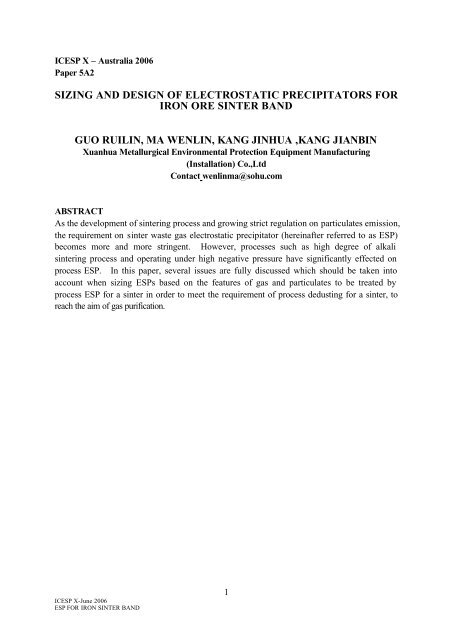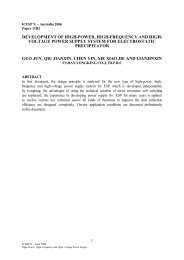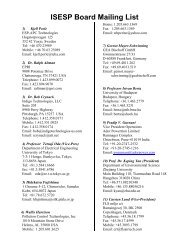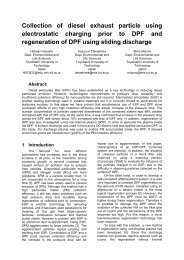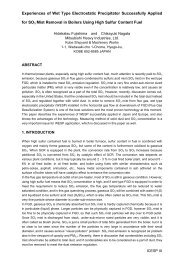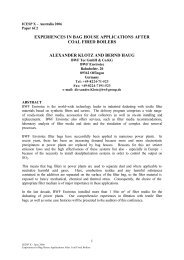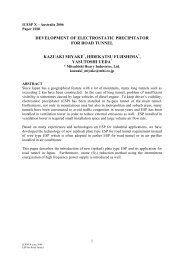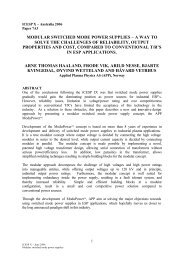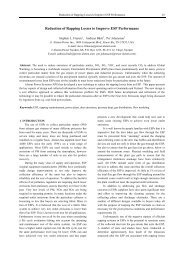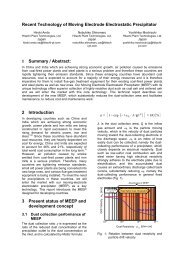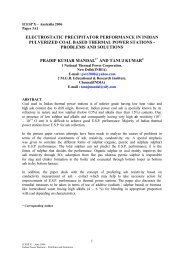sizing and design of electrostatic precipitators for iron ore - isesp
sizing and design of electrostatic precipitators for iron ore - isesp
sizing and design of electrostatic precipitators for iron ore - isesp
Create successful ePaper yourself
Turn your PDF publications into a flip-book with our unique Google optimized e-Paper software.
Calculation Method TwoCalculating according to Deutsch-Anderson equationn=1-e -AW/QWhere:Q--------gas flow at ESP inletA--------ESP collecting wall areaW-------dust migration velocityDeutsch-Anderson equation is the base <strong>of</strong> ESP <strong>sizing</strong> <strong>and</strong> we can tell from it that collectingefficiency can be high enough only when both A <strong>and</strong> W are as high as possible. The higher theW <strong>design</strong> value is selected, the less the A <strong>design</strong> value is, <strong>and</strong> the m<strong>ore</strong> economic, the m<strong>ore</strong>difficult to reach the required dust collecting efficiency. In contrast the higher the cost is <strong>and</strong>the easier to reach the required dust collecting efficiency.Find a point at which both factors are considered in selecting the <strong>design</strong> value <strong>of</strong> A <strong>and</strong> wbased on extended experience.Gas VelocityV=Q/F [4]Where:Q-----gas flowA-----ESP effective cross sectional areaToday normal Gas velocity V in electric field ranges 0.4 to 1.5m/s. We can tell fromDeutsch-Anderson equation that Gas velocity V in Field has nothing to do with collectingefficiency. Over high Gas velocity V in Field to a definite collecting wall area, however, notonly makes ESP longer, slenderer <strong>and</strong> occupy too much area, but also cause dust reentrant <strong>and</strong>down collecting efficiency. In contrast, under a certain gas flow to be treated the over lowGas velocity V in Field definitely leads to larger field cross sectional area, <strong>and</strong> makes ESPbigger <strong>and</strong> non uni<strong>for</strong>m gas distribution [5] .There<strong>for</strong>e the most economic Gas velocity V in Field should be selected to reach the requireddust collecting efficiency. Gas velocity V in Field is considered with gas features <strong>and</strong> dustfeatures as well. When dust particle size is large, dust quantity is large <strong>and</strong> specific resistivityis low Gas velocity V in Field can be raised properly. In contrast, when dust particle size is low,dust quantity is small <strong>and</strong> dust specific resistivity is high Gas velocity V in Field can bedecreased properly.Based on the gas <strong>and</strong> dust features <strong>of</strong> Sinter waste gas ESP, Gas velocity V in Field normallyranges 08. to 1.2m/s. Gas velocity V in Field normally does not go over 1.0m/s with Sinterwaste gas ESP which deals with gas having high content <strong>of</strong> K 2 O, Na 2 O <strong>and</strong> ZnO.ICESP X-June 2006ESP FOR IRON SINTER BAND4
Migration Velocity WMigration velocity equivalent <strong>for</strong>mula:W=KxEd 2Where:Kx----Comprehension varying factor <strong>of</strong> gas conditionA------Field operating voltageBasic factors which affect dust migration velocity W are particle size, resistivity, chemicalcomposition, electrode spacing <strong>and</strong> so on. Normally W is decided according to experience<strong>and</strong> ranges from 7 to 12 cm/s. W <strong>of</strong> 10cm/s is proper <strong>for</strong> Sinter waste gas ESP with electrodespacing 600mm <strong>and</strong> <strong>of</strong> 8cm/s is proper <strong>for</strong> Sinter waste gas ESP with electrode spacing400mm. W will be lower <strong>for</strong> dust <strong>of</strong> high content <strong>of</strong> K 2 O, Na 2 O <strong>and</strong> ZnO.ESP Height/Width RatioPointing to the features <strong>of</strong> fine particle, high viscosity <strong>and</strong> high moisture <strong>of</strong> sinter waste gas,ESP Height/Width Ratio <strong>for</strong> Sinter waste gas ESP should be selected less than 1.2, otherwisethe dust cake attached on upper part <strong>of</strong> collecting wall is hard to be rapped <strong>of</strong>f, <strong>and</strong> gasdistribution is affected, turbulence will occur <strong>and</strong> affect dust collecting efficiency. When ESPHeight/Width Ratio is over 1.2 because <strong>of</strong> space limit, a voice-wave dust cleaning device onESP top should be installed to ensure dust cleaning effect.SpacingThere exist several electrode spacing <strong>for</strong> sinter waste gas ESP such as 400mm, 450mm,500mm <strong>and</strong> 600mm. In our opinion electrode spacing 600mm is better according to ourdecades <strong>of</strong> experience. Generally thought that in wide electrode spacing sinter waste gas ESPelectric wind (ion wind) occurred under high voltage is utilized m<strong>ore</strong> to strengthen the dustmigration towards collecting electrode in addition to the original coulomb’s <strong>for</strong>ce. Whenvoltage rises over 100KV, the electric wind velocity adjacent to discharge electrode reaches 9to 13m/s, however, only 0.8 to 1.8m/s around collecting electrode. The electric wind velocityadjacent to discharge electrode reaches 5 to 8m/s, however, only 2 to 3m/s around collectingelectrode with conventional ESP [6] . From this the following advantages are obvious:• Dust migration velocity W is higher. We can tell from Deutsch-Andersonequation that collecting efficiency rises along with rising <strong>of</strong> dust migrationvelocity W.• Secondary voltage is raised with wide electrode spacing <strong>and</strong> this may enhancefield strength <strong>and</strong> suppress or delay the occurrence <strong>of</strong> back corona, keep the fieldstable.• The electric wind velocity adjacent to discharge electrode in wide electrode spaceESP is higher than that in conventional ESP <strong>and</strong> the electric wind velocityadjacent to collecting electrode in wide electrode spacing ESP is lower than thatin conventional ESP, so decreasing <strong>of</strong> collecting efficiency due to dust reentrantcan be reduced <strong>and</strong> good <strong>for</strong> fine dust capture.• Wide electrode spacing is good <strong>for</strong> gas with low inlet dust content <strong>and</strong> highICESP X-June 2006ESP FOR IRON SINTER BAND5
CONCLUSIONAs the development <strong>of</strong> sintering process <strong>and</strong> growing strict regulation on dust emission, therequirement on Sinter waste gas ESP becomes m<strong>ore</strong> <strong>and</strong> m<strong>ore</strong> stringent. There<strong>for</strong>e rational<strong>sizing</strong> <strong>of</strong> Sinter waste gas ESP is significant. Knowing the sintering process <strong>and</strong> dustcharacteristics well is the precondition to rational <strong>sizing</strong> <strong>of</strong> sinter waste gas ESP. Onlyrational <strong>sizing</strong> can meet the waste gas dust removing process requirements, to reach thepurpose <strong>of</strong> gas cleaning.REFERENCE[1] Shen Huiguo, Du Jianxin, Wu shengli. Experimental Research on Basic SinteringFeatures <strong>of</strong> Iron Ore powder, Metallurgical Research, 2005.[2] He Litang, Qi Fengming. Characteristics <strong>and</strong> Applications <strong>of</strong> Sinter waste gas ESP, 10 thNational Conference on Electrostatic Precipitation/2nd Desulfurization, Academic Discussion.2003[3] Qi Fengming, Yu Tianchi. Research on sinter waste gas ESP in Wu Han steel, Proceedings<strong>of</strong> 4 th International Conference on Electrostatic Precipitation, 1987[4] Liu Houqi, Lin Hong. Electrostatic Precipitator, China Construction Industry Press, 1987.[5] Electrostatic Precipitator <strong>for</strong> Coal Fired Power Station. Safety <strong>and</strong> Env<strong>iron</strong>mentalProtection Bureau, China Power Association Env<strong>iron</strong>mental Protection Company, 1993[6] Tan Tianyou, Liang Fengzhen. Industry Ventilation Dust Removing Technology, ChinaConstruction Industry Press, 1984[7] Dust Removing Equipment Design. Shanghai Science <strong>and</strong> Technology Press, 1985[8] Tan Tianyou, Wang Liqian. Electrostatic Precipitation, Hydraulic <strong>and</strong> Power Press, 1983ICESP X-June 2006ESP FOR IRON SINTER BAND9


